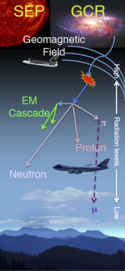Aurora-SpaceShuttle-EO
Autor:
Shortlink:
Zdroj:
Formát:
1782 x 1173 Pixel (571614 Bytes)
Popis:
The Aurora Australis as seen from the Space Shuttle Discovery on STS-39. The payload bay and tail of Discovery can be seen on the left hand side of the picture. Auroras are caused when high-energy electrons pour down from the Earth’s magnetosphere and collide with atoms. Red aurora occurs from 200 km to as high as 500 km altitude and is caused by the emission of 6300 Angstrom wavelength light from oxygen atoms. Green aurora occurs from about 100 km to 250 km altitude and is caused by the emission of 5577 Angstrom wavelength light from oxygen atoms. The light is emitted when the atoms return to their original unexcited state.
Komentář k Licence:
| This file is in the public domain in the United States because it was solely created by NASA. NASA copyright policy states that "NASA material is not protected by copyright unless noted". (See Template:PD-USGov, NASA copyright policy page or JPL Image Use Policy.) |  | |
 |
Warnings:
|
Licence:
Public domain
Relevantní obrázky
Relevantní články
Vesmírné počasíVesmírné počasí je termín, jímž se označují různé jevy ve vesmíru, které ovlivňují dění na Zemi, nebo ve sluneční soustavě. Jako vesmírné počasí se označují i aktuální podmínky v magnetosféře, ionosféře, termosféře a exosféře. Vesmírným počasím se zabývá jisté odvětví astrofyziky a aeronomie. Tyto jevy nelze spojovat s pozemským počasím atmosféry Země. .. pokračovat ve čtení




